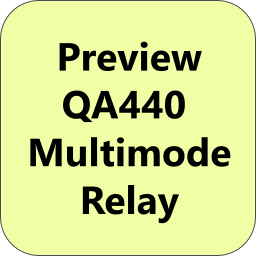
Preview: QA440 Multimode Relay
Share
The QA440 Multimode Relay provides 5-general purpose DPDT relays, accessible through two front-panel DB25 connectors wired in a Tascam DB25 audio pinout configuration.

The two DB25 connectors can be configured to provide 7 modes of switching operation, summarized below:

From the table above, you can see Mode 1 provides 5 stereo pairs of muxing, with a single mux pair appearing as follows:

Mode 7 allows you present the switch array as a single 6:1 mux. And of course, there are a lot of options in between. Since the switching mechanism is a relay, it's bi-directional and can be used as a 2:1 mux or 1 of 2 selector.
The various relays are presented on the front panel as follows:

In the picture above, you can see the standard DB25 pin numbers (inside the circles), the various group numbers (1..16, but not only group 1..15 are wired) and the color coding on the DB25 pins. Looking at a single DB25 we have the following:

In the diagram above you can see how the Hot/Cold signals are presented in each group.
All of the relays are under USB control. This allows Tractor to control the relays as part of your test flow. So, if you wanted to test a 5.1 amplifier (6 channels), you'd be able to provide 6 external loads to the amp, and then use the relay box to tap off of each load in sequence, and present those signals to the QA401. And then, under Tractor, you'd select channel 1, test THD, select channel 2, test THD, etc. This would allow you to test all channels under load.
Testing the QA401 in Manufacturing
During the factory test of the QA401, there are three configurations tested: All inputs grounded (to check noise), L- and R- ground and L+ and R+ IN to L+ and R- OUT(to check single ended performance), and all inputs driven (to check differential performance). To date, the configuration switching has been done by the operator switching BNC cables and shorting blocks (per on-screen instructions presented by Tractor). A connector board was made (shown below) that connects to the QA440 to automate this IO switching.

In the PCB layout above, note the 4 connectors on the left (each is a "stacked BNC" connector) are spaced to match in the 8 front-panel connectors on the QA401. On the right, is the DB25 connector. This breakout board above is connected to the QA440 using a low-cost "balanced snake" (link HERE at Amazon). While you could make the snake yourself (and there are plenty of how-to articles), the aim to to enable a standard pinout to permit low-cost long-runs of shielded cables to ensure a trouble-free installation in the harsh settings that factories often present.
The board shown above is the pushed onto the BNC connectors of the QA401, and the entire switching process is automated. No more manual cable switching or routing! Of course, you'd make your own PCB to facilitate breaking out the DB25 connector to whatever connector you might need.
Send a mail to the Support alias if you are looking for a relay box to try in your factory setup. First beta units should be ready in a 3-4 weeks.
Thanks, Matt
PS.
PS. This post can be discussed on the forum at the link HERE.
If you liked the post you just read, please consider signing up for our mailing list at the bottom of the page.
